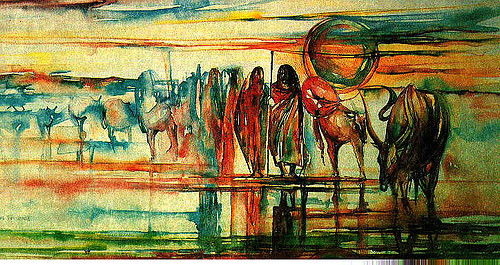
Maasai herding’, painting by Kahare Miano (photo credit: ILRI/Elsworth).
As the CGIAR Consortium prepares for its Thursday live interactive panel on challenges and solutions to the Food Crisis in the Horn of Africa, the Famine Early Warning Network (FEWS NET) reports that reliance on the Intergovernmental Panel on Climate Change climate model for long term climate adaptation and mitigation in East Africa greatly exacerbated the current crisis.
In a Nature News article We thought trouble was coming, FEWS Net's Chris Funk says because agencies working in the Horn of Africa relied upon the IPCC's prediction of increased precipitation in East Africa, they failed to heed early warnings of severe drought and wide-spread food insecurity.
The global climate models used by the Intergovernmental Panel on Climate Change were never intended to provide rainfall trend projections for every region. These models say that East Africa will become wetter, yet observations show substantial declines in spring rainfall in recent years. Despite this, several agencies are building long-term plans on the basis of the forecast of wetter conditions. This could lead to agricultural development and expansion in areas that will become drier. More climate science based on regional observations could be helpful in addressing these challenges.
While the IPCC's 2007 4th Assessment report, in its section 11.2.3.2 Mean Precipitation, does suggest a potential increase in precipitation in some areas of East Africa, upon evaluating all the data available at that time, the IPCC scientists concur:
While this result is generally consistent with the underlying GCMs and the composite MMD projections, there is a tendency for greater Sahel drying than in the underlying GCMs, providing further rationale (alongside the large spread in model responses and poor coupled model performance in simulating droughts of the magnitude observed in the 20th century) for viewing with caution the projection for a modest increase in Sahel rainfall in the ensemble mean of the MMD models.
The IPCCs Fifth Assessment Report is currently underway but is not scheduled for release until 2014.
Funk, a member of University of California, Santa Barbara, Department of Geology Climate Hazard Group, said FEWS began issuing early warnings last year after evaluating the impact of the La Niña weather system on East Africa.
FEWS NET runs a food-price tracking system that showed that the price of maize (corn) in Kitui, Kenya, had soared by 246% in 12 months. And the value of a goat in Bardera, Somalia, usually sold to buy grain, had halved. Satellite measurements of vegetation health tracked the emerging drought in disturbing detail. FEWS NET put out a second alert on 7 June that warned: “This is the most severe food security emergency in the world today, and the current humanitarian response is inadequate.”
Along with faulty climate modeling, which resulted in the unsustainable expansion of rain fed agriculture crops in dry pastoral ecosystems, Funk reports that population expansion and more frequent droughts have overwhelmed local agriculture systems.
Emergencies such as the one in East Africa will become more common unless there is a focus on improving agricultural production. Ironically, the fact that crop yields are low creates a tremendous opportunity for improvement. A 50%, or even 100%, increase in yields is feasible . . . . In the long term, a more resilient system is needed, rather than an increase in the number of emergency grain shipments. Then, when disaster strikes, surplus food can be moved around the region—from Tanzania to Somalia, say.
GET INVOLVED
CGIAR Consortium's Thursday press conference Research Options for Mitigating Drought-induced Food Crises focuses on solutions and challenges, and is informed by research on such topics as reintroducing traditional dry-land crops; implementing food storage systems; climate change and farming; micro-irrigation and the successful use of plant varieties; and inspiring and engaging youth in sustainable agriculture. (See Links Below.)
The meeting, which takes place at the ILRI campus in Nairobi, will be hosted on the Consortium's Horn of Africa page, where a live video link and chat channel provide opportunity for Q&A for remote participants. (Times: 10:30-12:00 Nairobi time; 09:30-11:00 CET; 07:30-09:00 GMT; 3:30- 5:00 EST; 0:30 - 2:00 PST ). Participants can submit comments or questions ahead of time on the HOA landing page; during the live event, questions can be submitted in real time via Twitter or the chat channel on the page.
Food Security Tool Kit
Micro-irrigation shows new ways to beat hunger
The revival of traditional dry-land crops
Report: Investments in Pastoralism Offers Hope for Combating Droughts in East Africa
The root causes of food insecurity in East Africa
Kenya: Not just droughts, but also minor climate shifts affect farmers
Maize: Not just a question of producing more, but also of storing better
Horn of Africa: The rains will fail in 2015, 2016, or 2017, but must we also fail?
Agricultural development: Not just about seeds,but also about inspiring young people
ICRISAT breeds improved plant varieties for Kenyan farmers
How many pictures of dead cattle does it take?
Follow the Leaders In Global Food Security
CGIAR The Consortium of International Agricultural Research Centers, established in 2010, as part of a major reform of CGIAR
The International Food Policy Research Instituteseeks sustainable solutions for ending hunger and poverty.
@CGIARConsortium
@ifpri Washington, DC
Famine Early Warning Network (FEWS NET)
@FEWSNet (Nairobi)


